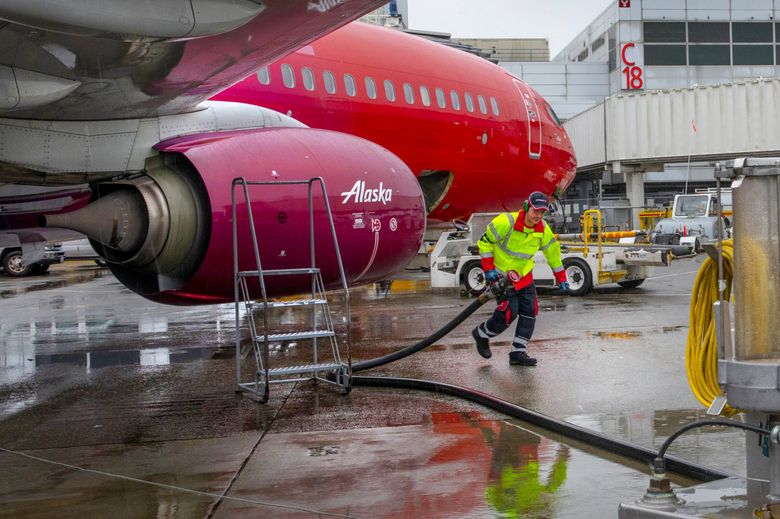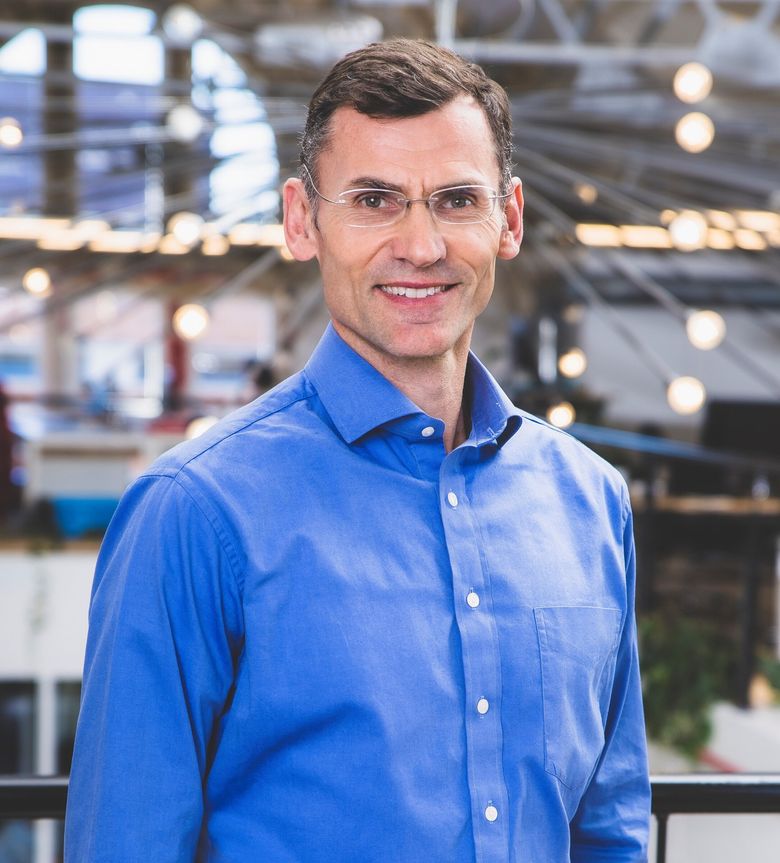Dutch company SkyNRG has chosen Washington state to locate a major new biogas plant that will produce sustainable aviation fuel — a key part of the airline world’s push to decarbonize flying.
In an interview Wednesday on the sidelines of a Boeing conference on aviation sustainability in Renton, SkyNRG CEO Philippe Lacamp said he expects the plant to be operational by 2028 or 2029. Its construction will provide about 600 jobs, and running it thereafter will provide about 100 permanent new jobs, he said.
Previously SkyNRG, which has its U.S. office in Bend, Oregon, had said it was looking for a location somewhere in the Pacific Northwest. Lacamp said new state legislation signed this month by Gov. Jay Inslee that provides sustainable aviation fuel, or SAF, subsidies and speeds permits for plant construction tip the scale for Washington.
The legislation “positions Washington state as the most attractive, most supportive state for SAF,” he said. “It’s the most generous state in the nation now.”
SkyNRG has been studying several potential locations in the state but Lecamp declined to identify them pending full “engagement” with the local communities. “We want to make sure that we’re a good neighbor,” he said.
The project to produce about 90,000 metric tons of SAF per year, about 30 million gallons, will require a huge investment of between $600 million and $800 million, he added.
Lecamp said he’s confident SkyNRG will nail down the equity and debt financing to cover that as the global aviation industry mounts a big push to reach net zero carbon emissions by 2050 — with large-scale SAF production accounting for fully 65% of the planned reduction.
“We see these technologies as being absolutely essential for the ongoing development of the aviation industry in terms of 2050 targets,” Lecamp said. “We have confidence that they can be financed.”
“There is capital available, even in the current macroeconomic situation,” he added. “There is a willingness to provide the capital.”
A bill sponsored by state Senate Majority Leader Andy Billig, D-Spokane, creates tax credits that will provide subsidies of up to $2 per gallon for SAF, which is 2 to 5 times more expensive than regular jet fuel that currently costs about $2.17 per gallon.
A separate bill will accelerate permitting and environmental review for construction of clean energy plants.
“This is what we hoped would happen,” Billig said Thursday. “It’s rewarding to see this bill pay dividends for the state so quickly.”
Enormous challenge to produce enough SAF
For Wednesday’s aviation sustainability conference in Renton, Boeing brought together leading representatives of airlines, Wall Street financiers, global aviation regulators and government policymakers to discuss the challenge of aviation meeting its goal to decarbonize by 2050.
Aviation today contributes about 2.5% of worldwide carbon emissions, a relatively small percentage but one expected to grow as air travel expands around the globe.
Because of the huge energy intensity required to haul hundreds of people safely across the skies, flying is one of the most difficult modes of transportation to decarbonize.
Electric batteries to power bigger airplanes are impractical, as they’d be too heavy.
The industry’s plan for net zero by 2050 includes switching out older planes flying today for much more efficient ones and eventually coming up with electric, hybrid-electric and hydrogen-powered alternatives for smaller airliners.
However, the bulk of the reduction is planned to come from using SAF, a hydrocarbon fuel that performs exactly like the kerosene-based fuel in current jet engines but is sourced from a variety of renewable feedstocks instead of from fossil fuels.
This transition to decarbonized flying will be costly, as air travelers will discover in the years ahead, because SAF is expensive to produce.
Willie Walsh, director general of the International Air Transport Association, or IATA, warned via video conference from Geneva on Wednesday that airlines will have to pass along the extra cost of SAF in higher ticket prices.
Before we get there though, the biggest issue is that, after years of talk about developing SAF, there is precious little actually produced.
Last year, less than 0.1% of the fuel used in airplanes worldwide was SAF. Just two producers supply SAF commercially in the U.S.
World Energy and Neste last year provided less than 16 million gallons of SAF made from cooking oil and animal fats to Los Angeles and San Francisco airports. That was the total U.S. production.
For perspective, United Airlines Chief Sustainability Officer Lauren Riley said United uses 4 billion gallons of fuel a year.
The White House has set goals to produce 3 billion gallons of SAF per year by 2030, and 35 billion gallons per year by 2050.
Going from almost nothing to producing the required quantities of SAF is daunting.
“We recognize that this is going to be incredibly challenging, but it is achievable,” IATA’s Walsh told the conference. “And we are absolutely determined to do everything we can to achieve that goal.”
Chris Raymond, Boeing’s chief sustainability officer, said in an interview that failing to produce SAF at large scale could stunt the growth of aviation as governments impose limits on carbon emissions.
“That is the threat that sits out there,” Raymond said.
Boeing is using its clout to try to get movement. It partnered with SkyNRG specifically by committing in 2021 to the advance purchase of SAF from its facility here for use in Boeing flight tests and other operations.
Boeing also lobbied in Olympia for the passage of the clean energy bills to support SAF production.
And Raymond said Boeing union leader Jon Holden, District 751 president at the International Association of Machinists, played a strong role in convincing the Legislature to support the bills.
SkyNRG’s ambitions
Nascent industry that it is, SAF production is now being boosted to life by government support in Europe and the U.S. — with California and now Washington leading the way here.
Several different chemical mechanisms are being developed to produce the fuel from various carbon sources, which are referred to as “feedstocks.”
Production from used cooking oil and fats is the most established pathway, but scaling that to the required levels has limits. As Angela Wilkinson, CEO of the World Energy Council, put it, “There’s only so much fried chicken people can eat.”
Since its founding in 2009 — spun off from a study done for Dutch airline KLM, which is a shareholder in the company — SkyNRG has been focused entirely on developing SAF technology.
Yet it is essentially still a startup, with only about 50 employees and just three of those in the U.S.
Still, it has partnerships with Boeing and with major airlines and it has huge ambitions.
In Holland, Lacamp said it is closing in on a final investment decision on a plant producing SAF via the used oils and fats pathway.
But the one it plans for Washington state will use a different chemical pathway: It’s dubbed “alcohol-to-jet” and consists of fermenting carbon waste to produce ethanol that is then converted to fuel.
The feedstock will be waste gases, chiefly methane, derived from agricultural or municipal landfill waste.
“Think around dairy farms, for example,” Lacamp said.
Yes, he means cow farts and cow manure. “It can be captured under canopies. There’s all sorts of ways dairy farms find of capturing biogas,” he added.
Even more ambitiously, SkyNRG plans another plant in Holland using a third, different pathway — the greenest SAF of all — called “power-to-liquid,” which uses renewably sourced electricity to produce “green hydrogen” that is then combined with carbon dioxide captured from the atmosphere to produce fuel.
These latter two SAF pathways are new and in development. They’ve been shown to work in a lab but have never been used on an industrial scale.
“We are a novel technology and that comes with a level of risk,” Lecamp said. “Matching the capital with the appetite to accept a level of risk which is higher than what you now see in wind turbines and solar farms, that is more challenging.”
For investors to take that risk with a huge amount of capital, they must be convinced of a long-term market for the SAF product.
It will require more than noble declarations of intent from the aviation industry.
Joe Shanahan, managing director, head of aviation at investment bank Citi, said investors will hesitate until airlines step up and sign long-term contracts to buy the fuel, despite the premium price.
The Washington state per-gallon subsidy could prove critical for that to happen.
In 2021, Alaska Airlines agreed to work with SkyNRG and Lecamp said it’s “one of many airlines keen to take part” by committing to buy SkyNRG’s SAF.
All the larger airlines flying out of Seattle-Tacoma International Airport, including Delta and Southwest, could equally have an interest in locally produced SAF.
The future of aviation is being gambled on this technology play. Lacamp estimated that 750 SAF plants will have to be built at enormous cost to meet the capacity targets of just the U.S. and the European Union.
The one planned for Washington state will be leading edge, he said.
“When you’re doing the first-of-a-kind facility, you’re going to learn a lot,” said Lecamp, adding that the lessons will then be applied to replicate similar plants around the world.
“From the very beginning, this company has been focused on sustainable aviation fuel,” Lecamp said. “We understand the feedstocks. We understand the technologies. We know that it has to happen for aviation to reach its 2050 net zero target. And we’re all in on that.”


